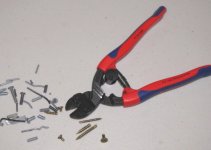six-point socket II
Member
- Joined
- Jun 26, 2016
- Messages
- 2,232
Hi!
I was asked about some more information on the Knipex CoBolt "pocket" bolt-cutter by one of our dear FOG moderators
 which I happily compiled.
which I happily compiled.
It might be informative also for other FOG members that's why he suggested I start this thread.
So here's what I sent:
Some more information on the Knipex CoBolt XL (10" / 250) Version can be found here, it's pretty new:http://www.knipex.com/index.php?id=1216&L=1&page=group_detail&parentID=1367&groupID=2430
Kind regards,
Oliver
I was asked about some more information on the Knipex CoBolt "pocket" bolt-cutter by one of our dear FOG moderators
It might be informative also for other FOG members that's why he suggested I start this thread.
So here's what I sent:
(...)
I have the 72 32 200 (http://www.knipex.com/index.php?id=1216&L=1&page=art_detail&parentID=1367&groupID=1473&artID=20523 )
When I bought it there was no CoBolt XL (10" / 250) - So I didn't have a choice size wise, but still I would not get the XL because it's not available with a what Knipex translates as "Multi-Component"-Grip. Which is basically superior in all aspects to the simple "plasti dip" type handle. I would not recommend the latter - they're less comfortable, they hurt more when you apply real pressure on them, they are quite a bit more slippery. And reaching for the XL would (for me, anyway) translate to: I need to cut large diameter stuff regularly and often - and I think a real bolt cutter would be way better suited for that. The CoBolt is just like a SAK - it can cut a lot of different diameters and even piano wire up to 3.2 mm - but it's the pocket version of a bolt cutter. Doesn't mean it's not serious business - as you will see.
Next: angled or straight. Straight all the way for me. Why? I have never come across something where I would have needed a angled cutting head because whatever it was couldn't be cut with a straight head. And, I feel like you're giving up power/control with the angled head. But like I said, this comes purely from never needing a angled head. One thing maybe: If you need to cut something off flush, than the angled version would be superior
The notch/recess: It's both, heaven and heck. Heaven because it really does make cutting larger diameter and hard material easier, heck because, depending on the material/hardness it will not cut through. So if it's really hard material and cracks easily you can go through in one attempt, if it's rather soft and it bends before it cracks - you will have to re-place whatever you're cutting to the front portion of the head and cut through in a second attempt. You will see this in the video
As you found out already, all of them are high leverage diagonal cutters.I have honestly no idea what they mean by fencing in this context.
Lets start with my short picture/video review
Here's the video link:http://sendvid.com/5iw6fdtd
From 00:00 - 00:09 I'm trying to cut a 6mm machine screw (steel, galvanized and blue chromated) in the front portion of the head.
From 00:09 - 00:16 I switched to the notch/recess and cut it with significantly less force as you can see.
From 00:23 - 00:25 I pre-cut a 4mm (A2) Spax in the notch/recess
From 00:25 - 00:28 I finish the cut in the front portion of the head. (This is what I meant with rather soft stuff being "heck" in the notch/recess, it will not cut through)
From 00:29 - 00:32 I cut a typical framing/roofing nail
From 00:33 - 00:35 I cut another, smaller nail. Typical "does it all/ all-purpose household nail"
From 00:36 - 00:42 I cut another machine type screw, somewhere around 4mm.
From 00:43 - 00:59 I cut another typical wood/all-purpose screw, again because these are rather soft, you can see I need to change from notch/recess to front portion of the head. Of course you can prevent that by simply cutting in the front portion of the head and not using the notch/recess on rather soft material.
Pictures:
The 6mm machine type screw:

The Spax:

The "mess" I've made

Jaw/cutting edge shot - as you can see, absolutely no dents in the edges. And this was of course used before. But you can also see that the notch/recess is quite serious in depth, which explains the "trouble" with softer materials.

So, I'd say you'd be best suited with the 72 32 200 I have
Hope this helps!
(...)
Some more information on the Knipex CoBolt XL (10" / 250) Version can be found here, it's pretty new:http://www.knipex.com/index.php?id=1216&L=1&page=group_detail&parentID=1367&groupID=2430
Kind regards,
Oliver

